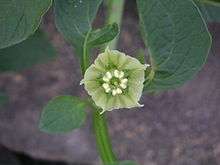Jaltomata procumbens
Jaltomata procumbens, the creeping false holly,[2] is a plant species native to Arizona, USA, Mexico, Central America, Colombia, Ecuador, and Venezuela. It grows as a weed in agricultural fields and other disturbed locations, but in many places the people protect it because of the edible fruits it produces.[3][4][5][6][7][8][9]
| Jaltomata procumbens | |
|---|---|
 | |
| Jaltomata procumbens flower | |
| Scientific classification | |
| Kingdom: | Plantae |
| Clade: | Tracheophytes |
| Clade: | Angiosperms |
| Clade: | Eudicots |
| Clade: | Asterids |
| Order: | Solanales |
| Family: | Solanaceae |
| Genus: | Jaltomata |
| Species: | J. procumbens |
| Binomial name | |
| Jaltomata procumbens (Cav.) J.L. Gentry | |
| Synonyms[1] | |
| |
Jaltomata procumbens is a spreading, trailing to ascending herb forming many shoots from a single root. Leaves are broadly lanceolate, up to 20 cm long, dark green. Flowers are rotate, pale yellow-green with darker green spots toward the center. Berries are dark purple, spherical, about 1 cm in diameter, with a strong scent resembling that of grapes (Vitis spp.). [10][11]
Uses
The fruit has a pleasant taste and aroma and is prized as a food source by many peoples. The Tarahumara and Pima Bajo (Mountain Pima) peoples of the Sierra Madre Occidental of northwestern Mexico recognize the species when it grows in their agricultural fields, but protect it and encourage its growth. Many crop historians believe that many other species now recognized as crops began the process of domestication under similar circumstances, as volunteers in fields planted to other species.[12][13][14]
References
- Tropicos
- "Jaltomata procumbens". Natural Resources Conservation Service PLANTS Database. USDA. Retrieved 26 May 2015.
- Brako, L. & J. L. Zarucchi. (eds.) 1993. Catalogue of the Flowering Plants and Gymnosperms of Peru. Monographs in systematic botany from the Missouri Botanical Garden 45: i–xl, 1–1286.
- Dodson, C.H. & A.H. Gentry. 1978. Flora of the Río Palenque Science Center: Los Ríos Province, Ecuador. Selbyana 4(1–6): i–xxx, 1–628.
- Dodson, C.H., A.H. Gentry & F.M. Valverde Badillo. 1985. Flora de Jauneche 1–512. Banco Central del Ecuador, Quito.
- Hokche, O., P. E. Berry & O. Huber. (eds.) 2008. Nuevo Catálogo de la Flora Vascular de Venezuela 1–860. Fundación Instituto Botánico de Venezuela, Caracas. Reference article
- Idárraga-Piedrahita, A., R. D. C. Ortiz, R. Callejas Posada & M. Merello. (eds.) 2011. Flora de Antioquia: Catálogo de las Plantas Vasculares 2: 9–939. Universidad de Antioquia, Medellín.
- Pérez J., L. A., M. Sousa Sánchez, A. M. Hanan-Alipi, F. Chiang Cabrera & P. Tenorio L. 2005. Vegetación terrestre. 65–110. In Biodiversidad del Estado de Tabasco. CONABIO-UNAM, México
- Jaltomata Schlechtendal (Solanaceae), Professor Thomas Mione, Central Connecticut State University
- Gentry, J.L. 1973. Restoration of the genus Jaltomata (Solanaceae). Phytologia 27:286-287.
- Ruiz López, Hipólito, & Pavón, José Antonio. 1799. Flora Peruviana, et Chilensis 2: 43.
- Pennington, CW. 1963. The Tarahumar of Mexico, their material culture. University of Utah Press, Salt Lake City
- Laferrière, Joseph E., Charles W. Weber and Edwin A. Kohlhepp. 1991. Use and nutritional composition of some traditional Mountain Pima plant foods. Journal of Ethnobiology 11(1):93-114.
- Mione, Thomas, & Robert C. Bye Jr. 1996. Jaltomata chihuahuensis (Solanaceae), a new combination and observations on ecology and ethnobotany. Novon 6:78-81.